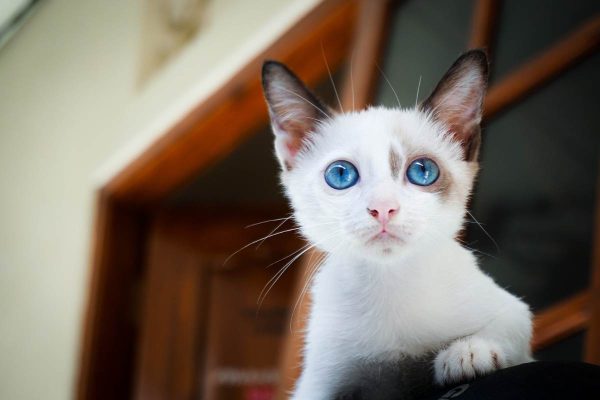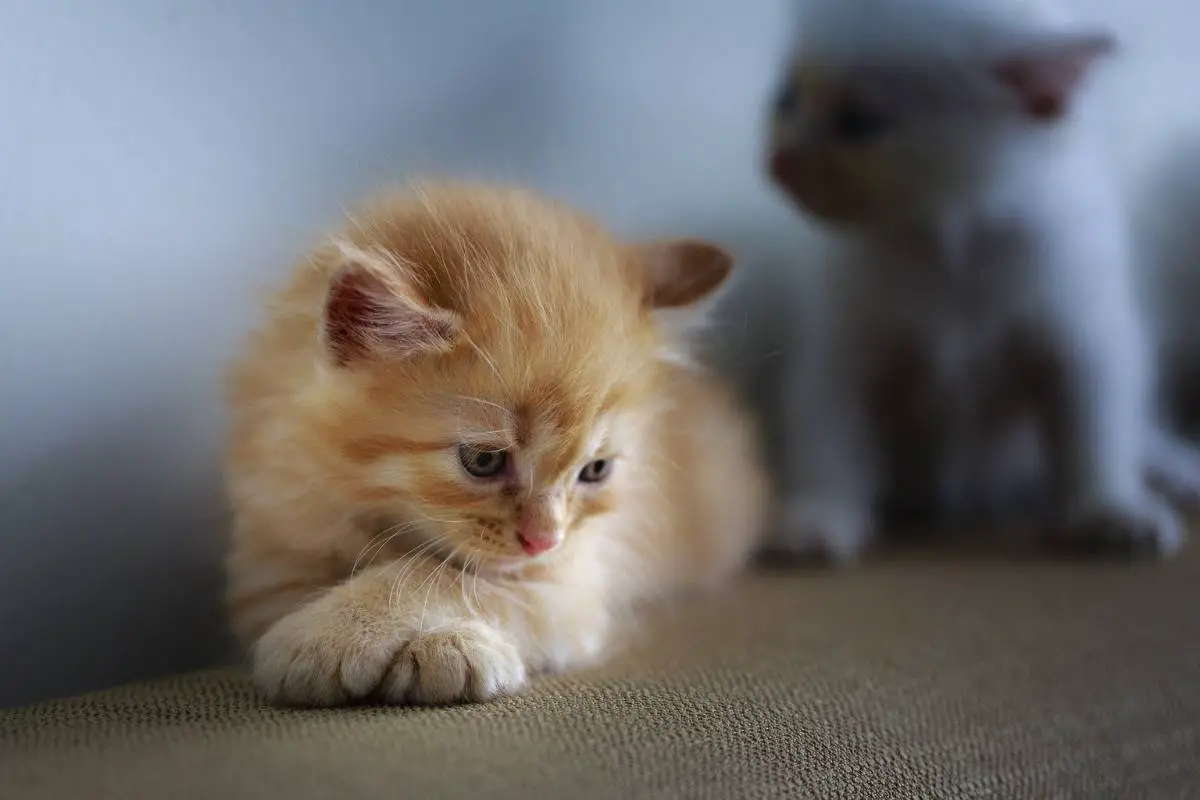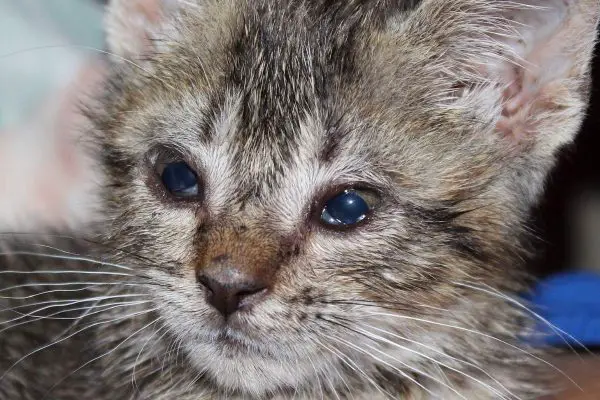Your cat staring intently at something you can’t see can be slightly unsettling. Typically, when an animal or a person stares at something, we can see what they’re looking at, but occasionally, when cats stare at the ceiling, we have no idea what has caught their attention. This feline habit has given rise to the myth that cats can see the supernatural or ghosts.
So, why is my cat always looking at the ceiling? The reason your cat is looking at the ceiling, or the wall, or even at the floor, is because their eyesight is much different from ours. Where you see nothing at all, they might see a tiny bug, a piece of drifting dust, or a strand of cobweb.
Cats stare because they see tiny things that we can’t, and there’s no need to be concerned with this behavior. However, if you notice that your cat appears to be staring without focus, its eyes are glassy, or there are noticeable changes to the appearance of your cat’s eyes, you should contact your vet.
What Your Cat Sees
Human vision is something most of us are all very familiar with. We can see near and far, color and shadow, all thanks to the organs that are our eyes. Cats, however, see things very differently than us, thanks to their higher number of ‘rod’ cells in their retina—they have six to eight times more rod cells than we do.
To put that in perspective, the human eye has around 91 million rod cells, the cells that operate under low-light conditions; cats have somewhere between 546 million and 728 million.
Therefore, cats are far better at seeing in the dark than we are. So if you are in a dim room with your cat, and your cat is staring at something, it’s likely that your pet is seeing something small moving in the shadows that your eyes are not equipped to see.
Glowing Eyes

In addition to their high number of low-light receptors, cats eyes also contain something ours do not: a thin, reflective membrane called the tapetum lucidum which catches any and all available light and reflects it into the photoreceptors at the back of the eye, maximizing the quantity of light available to the eye.
The tapetum lucidum is what you see when your cat’s eyes are glowing in the dark, or appear to shine like lamps in a flash photo. It’s creepy when you aren’t expecting it, but it’s an important part of what makes your cat so good at seeing late in the evening!
Nighttime Hunting
Humans are diurnal, meaning that we live most of our lives during the day, and sleep at night. Cats, on the other hand, are better suited to being awake during the early morning or twilight hours, thanks to the tapetum lucidum and their increased rod count letting them see better in dim lighting.
These low-light times are when their prey, like rodents, tend to be active and out on the ground. Your cat’s eyes operate in such a way that dim light and sudden, darting movements are extremely clear to them. In fact, cats instinctively react to small, abrupt movements better than we do, specifically because their eyes see less movement overall than we do.
Why Less Movement

Humans are equipped to see both far away and nearby because of muscles in the eye that help the lens of our eye shift to allow the bending of light; cats are not able to do this in the same way. Where the average human’s vision is 20/20, a cat’s vision is anywhere from 20/100 to 20/200, or very nearsighted.
This means that what we can see easily at 200 feet away, a cat would only be able to see from twenty feet away. While we see all sorts of movement during the day– cars in the distance, people up close– cats tend to only notice movement that is within twenty feet of them.
This is because cats, as predators, are adapted to pay more attention to movement within good hunting distance. Anything beyond that is blurry and less likely to be seen.
Because of this adaption, cats are extremely attuned to motion within range of their eyesight, and so any little movements nearby, whether a feather toy on a string or a moth fluttering near the window, will attract their attention. Just because they see less than we do, doesn’t mean they aren’t excellent hunters!
Perfectly Normal
Your cat and you see the world in very different ways, and though that may lead to some misunderstandings, it can also lead to you noticing things you might not have. Your cat staring intently at something you can’t see is perfectly normal, and if you look closer where they’re staring may lead to you discovering something you might have not noticed before, like a tiny fly or a scrap of floating feather—or even something small and shiny that you recently dropped that has caught your pet’s interest.
Your cat is very attuned to its environment, and having it notice things out of the ordinary is normal.
Cat Eyesight and What to Look For
Most of the time, cats fixating on something invisible is just typical cat behavior. However, if you notice increased quantities of staring, staring without focus, or notice that your cat’s eyes are glassy, irritated, or swollen, there may be cause for concern.
Eye Injuries

Cats possess a third eyelid, called the ‘haw’, that adds extra protection to the eye from stray facial hairs and scratches from the environment or disagreements with other cats. However, despite the haw, there is a possibility for your cat to receive a scratch to the cornea, or outer lens of the eye.
Corneal scratches, also called corneal abrasions, are very painful, and your cat will let you know as much. Your cat will rub its eye with either its paws or against carpet or cushions, keep its eye tightly closed or squinted, and you’ll notice tearing or discharge from the eye. Fortunately, this injury is easily treated with medication, and with your help, it will resolve within a week.
Infections
Since cats are naturally curious and exploratory creatures, there is the possibility that your pet will encounter fungus or bacteria that affect the eyes. It’s always wise to pay attention to any signs of infection, such as running eyes or nose, increased pawing at the face, swollen eyelids, and/or redness around or in the eyes.
One of the most common infections is conjunctivitis, also called pinkeye, a highly contagious infection of the eye that is easily identified by the presence of irritated, itchy eyes and sticky tears.
This infection frequently appears in cats who have spent time in animal shelters, and if you have recently brought your cat home, its best to make sure your new pet is completely healthy before you introduce them to the other pets in your household, due to the high rate of infection.
Fortunately, conjunctivitis is easily treated by a vet, and, with some antibiotics and time, your pet will be back to normal, and much more comfortable.
Old Age and Eyes
Just like in people, cats’ eyesight can deteriorate with age. If you notice that your older cat is not only staring at nothing, but that their eyes appear unfocused, or that your cat occasionally bumps into furniture that it has previously avoided, there may be a serious problem.
Glaucoma, or high eye pressure, could be affecting your cat’s vision; cataracts, or cloudiness over the eye, could also be the problem. There are a wide variety of eye-related illnesses that affect older cats, and it is essential to get your cat to the vet as soon as possible.
Permanent blindness can result from any of these illnesses, and your cat’s vision is important. Eyes are very sensitive and delicate organs, and the faster the problem is diagnosed, the more likely it is that your cat’s vision will not be permanently affected.
Conclusion
Cats, ultimately, are animals who have adapted to be hunters. Because of this, their eyesight is very different from ours, and they tend to focus on things that we would otherwise not notice. So, when you see your cat staring intently at your ceiling, there’s no need to be afraid of any supernatural force lurking there, or be worried for your cat’s health—or feel judged for your choice of décor.
Your pet is merely looking at something that has caught their eye in the dark places under the sofa or the corners of the room. It may even be interesting to try and find what they are looking at!
However, as with all things in your cat’s behavior, if you notice anything out of the ordinary, such as excessive ‘blank stare’ behavior, increased rapid blinking, irritation to the eye or unusual tearing or discharge from the eyes, its best to take your cat to the vet as soon as you can.

